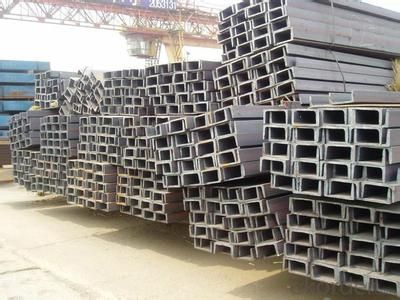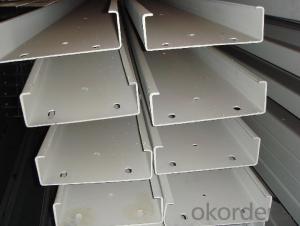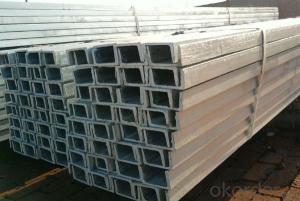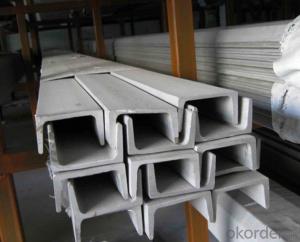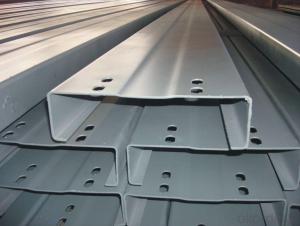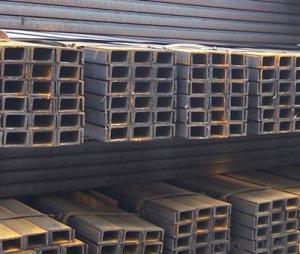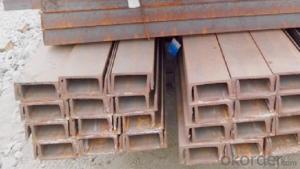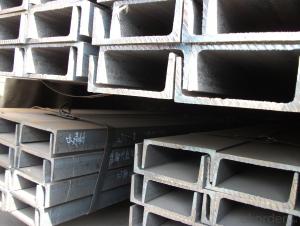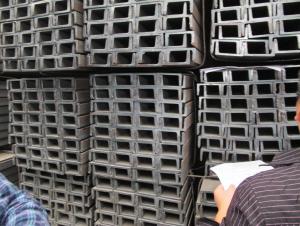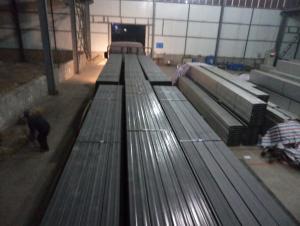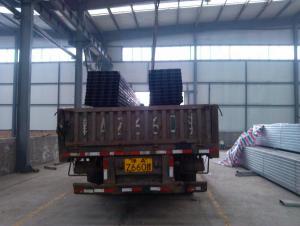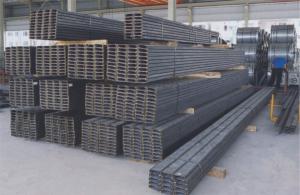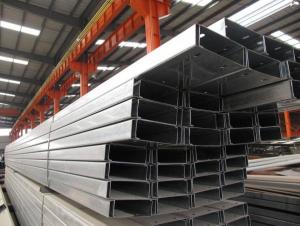Hot Rolled Channel Steel, Channel Bar JIS Standard
- Loading Port:
- Qingdao
- Payment Terms:
- TT OR LC
- Min Order Qty:
- 2000 PCS
- Supply Capability:
- 38000 PCS/month
OKorder Service Pledge
OKorder Financial Service
You Might Also Like
JIS Standard Hot Rolled Channel Steel, Channel Bar Details
| Standard: | BS,DIN,GB,JIS | Dimensions: | 50 mm to 200 mm | Grade: | SS400-SS540;S235JR-S275JR or Equivalent |
| Place of Origin: | China (Mainland) | Brand Name: | CNBM | Shape: | U Channel |
| Application: | applications that require a strong steel framework, like warehouses et | Perforated Or Not: | Not Perforated | Length: | 6-12m |
| Certification:: | SGS,CIQ | Name: | Jis Standard Hot Rolled Channel Steel, channel bar | Carbon: | low carbon |
Packaging & Delivery
| Packaging Detail: | Packing in bundles |
| Delivery Detail: | 30 to 45 days |
JIS Standard Hot Rolled Channel Steel, Channel Bar Specifications
Standard Sectional Dimension (mm) | Web thickness (mm) | Flange thickness (mm) | Weight (kg/m) |
50*25 | 3.00~5.00 | 6.00 | 2.37~3.46 |
75*40 | 3.80 | 7.00 | 5.30 |
75*40 | 4.00 | 7.00 | 5.60 |
75*40 | 4.50 | 7.00 | 5.85 |
75*40 | 5.00 | 7.00 | 6.92 |
100*50 | 3.80 | 6.00 | 7.30 |
100*50 | 4.20 | 6.00 | 8.03 |
100*50 | 4.50 | 7.50 | 8.97 |
100*50 | 5.00 | 7.50 | 9.36 |
125*65 | 5.20 | 6.80 | 11.66 |
125*65 | 5.30 | 6.80 | 12.17 |
125*65 | 5.50 | 8.00 | 12.91 |
125*65 | 6.00 | 8.00 | 13.40 |
150*75 | 5.50 | 7.30 | 14.66 |
150*75 | 5.70 | 10.00 | 16.71 |
150*75 | 6.00 | 10.00 | 17.90 |
150*75 | 6.50 | 10.00 | 18.60 |
200*80 | 7.50 | 11.00 | 24.60 |
200*90 | 8.00 | 13.50 | 30.30 |
250*90 | 9.00 | 13.00 | 34.60 |
JIS Standard Hot Rolled Channel Steel, Channel Bar Pictures
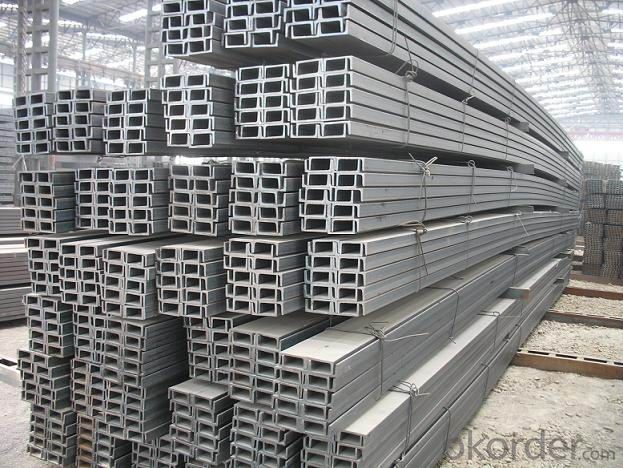

- Q: Can steel channels be used in signage applications?
- Yes, steel channels can be used in signage applications. They provide durability, stability, and a sleek appearance, making them suitable for outdoor and indoor signage installations. Additionally, steel channels can be easily customized and fabricated to meet specific design requirements, making them a versatile choice for signage applications.
- Q: Can steel channels be used for retaining walls?
- Yes, steel channels can be used for retaining walls. Steel channels offer several advantages for retaining walls, including their high strength, durability, and resistance to corrosion. They are capable of withstanding heavy loads and can be easily customized to meet specific design requirements. Additionally, steel channels provide a long-lasting solution for retaining walls and can be used in a variety of applications, such as commercial, industrial, and residential projects. However, it is important to consider factors such as soil conditions, drainage, and engineering requirements when selecting and designing a steel channel retaining wall to ensure its effectiveness and stability.
- Q: Can steel channels be used for automotive applications?
- Indeed, automotive applications can make use of steel channels. In a multitude of industries, including automotive manufacturing, steel channels are renowned for their versatility and widespread use. They are frequently employed in the creation of vehicle frames, chassis, and structural components due to their remarkable strength, durability, and capacity to endure substantial loads. By offering exceptional support and stability, steel channels guarantee the structural integrity and safety of automobiles. Furthermore, steel channels can be tailored and manufactured to fulfill the precise needs of automotive applications, thereby establishing themselves as a dependable selection in the automotive sector.
- Q: Can steel channels be used for scaffolding?
- Indeed, scaffolding can utilize steel channels. Given their strength and durability, steel channels prove apt for bearing substantial loads and offering a steadfast surface for laborers. Additionally, their simple assembly and disassembly foster adaptability and adjustability within scaffolding frameworks. Furthermore, steel channels exhibit resistance to corrosion and endure inclement weather, thereby establishing themselves as a dependable option for outdoor scaffolding. All in all, steel channels furnish the essential robustness and stability indispensable for scaffolding, rendering them a frequently employed material within the construction sector.
- Q: Can steel channels be used for supporting walkways and platforms?
- Yes, steel channels can be used for supporting walkways and platforms. Steel channels are strong and durable, making them suitable for providing structural support in such applications. They can be designed and installed to bear heavy loads and ensure the safety and stability of walkways and platforms.
- Q: Can steel channels be used for both residential and commercial applications?
- Steel channels have a wide range of applications, both in residential and commercial settings. They are versatile and durable components that can be utilized in various construction projects. In residential settings, steel channels can be employed for framing walls, supporting ceilings, and creating structural supports for staircases and balconies. They are also commonly utilized in commercial settings, including warehouses, factories, and office buildings. With their excellent strength and load-bearing capacity, steel channels are suitable for projects of different sizes and complexities in both residential and commercial sectors. Moreover, their resistance to corrosion and fire makes them highly suitable for both types of applications.
- Q: What are the different types of connections used for steel channels in steel bridges?
- There are several types of connections used for steel channels in steel bridges, including bolted connections, welded connections, and hybrid connections. Bolted connections involve using bolts to join the steel channels together, providing flexibility and ease of installation. Welded connections involve fusing the steel channels together using welding techniques, providing a strong and permanent connection. Hybrid connections combine both bolted and welded connections, utilizing the advantages of both methods for optimal performance and ease of construction. The choice of connection type depends on factors such as design requirements, load capacity, and construction constraints.
- Q: Can steel channels be used for load-bearing walls?
- No, steel channels are typically not used as load-bearing walls in construction.
- Q: Can steel channels be used in the chemical manufacturing industry?
- Steel channels are indeed applicable in the chemical manufacturing industry. These channels offer structural support and find use in diverse applications, including the construction of chemical storage tanks, platforms, walkways, and support structures for equipment and piping systems. Steel is renowned for its durability, strength, and resistance to corrosion, making it well-suited for chemical environments that often entail exposure to corrosive substances and high temperatures. Moreover, steel channels can be tailored and manufactured to fulfill specific design needs, providing flexibility during construction and installation. All in all, steel channels emerge as a dependable and adaptable option for the chemical manufacturing industry.
- Q: How do steel channels contribute to the overall ease of maintenance for a structure?
- Steel channels contribute to the overall ease of maintenance for a structure in several ways. Firstly, steel channels provide structural support and reinforcement to the building, ensuring its stability and longevity. This reduces the need for frequent repairs and maintenance, as the structure can withstand external forces such as wind, earthquakes, and heavy loads without significant damage or deformation. Additionally, steel channels are highly durable and resistant to corrosion, rust, and decay. Unlike other materials such as wood or concrete, steel channels do not rot, warp, or deteriorate over time. This eliminates the need for regular inspections, repairs, or replacements due to structural degradation. Furthermore, steel channels can be easily fabricated and installed, allowing for efficient construction and maintenance processes. The versatility of steel channels enables engineers and architects to design and modify structures with ease, facilitating any necessary repairs or renovations. This results in reduced downtime and disruption during maintenance activities. Moreover, steel channels have a high strength-to-weight ratio, making them lightweight yet incredibly robust. This feature simplifies the transportation and handling of steel channels during maintenance projects. It also reduces the need for extensive structural modifications, as steel channels can often be added or replaced without compromising the overall integrity of the structure. Lastly, steel channels can be fire-resistant, providing an added layer of safety and ease of maintenance. In case of a fire incident, steel channels can help contain the spread of flames, minimize damage, and facilitate the restoration process. This reduces the complexity and cost of maintenance in the event of fire-related incidents. In summary, steel channels contribute to the overall ease of maintenance for a structure by providing structural support, durability, corrosion resistance, ease of fabrication and installation, lightweight design, and fire resistance. These characteristics result in reduced maintenance requirements, increased structural integrity, and improved cost-effectiveness over the lifespan of a building.
Send your message to us
Hot Rolled Channel Steel, Channel Bar JIS Standard
- Loading Port:
- Qingdao
- Payment Terms:
- TT OR LC
- Min Order Qty:
- 2000 PCS
- Supply Capability:
- 38000 PCS/month
OKorder Service Pledge
OKorder Financial Service
Similar products
Hot products
Hot Searches
Related keywords


